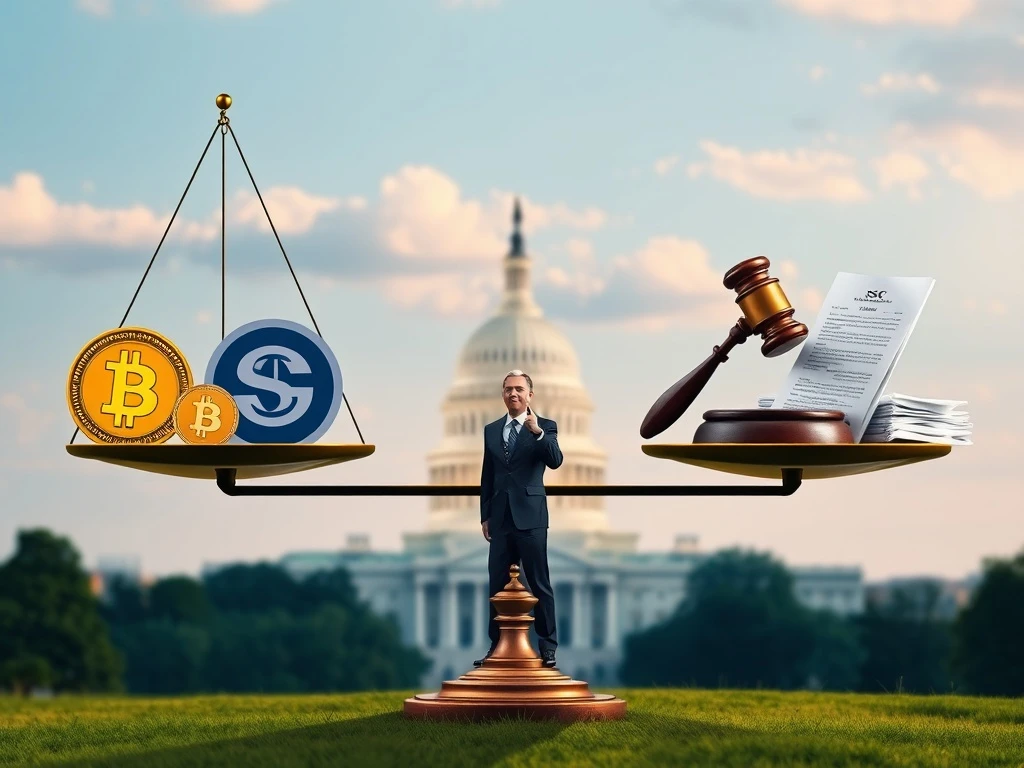Pivotal Shift: SEC Crypto Enforcement Promises Clearer Path Under Paul Atkins

The landscape of SEC crypto enforcement is undergoing a significant transformation. Many cryptocurrency businesses and enthusiasts have long sought clearer regulatory guidelines. Now, a new era appears to be dawning under the leadership of SEC Chair Paul Atkins. This shift promises a more structured and predictable environment for digital asset companies operating in the United States. Stakeholders across the industry are closely watching these developments.
A Clearer Path for Crypto Regulation Under Paul Atkins
SEC Chair Paul Atkins has signaled a fundamental change in the agency’s approach to the cryptocurrency industry. In a recent interview with the Financial Times, Atkins outlined a departure from the previous “enforcement-first” strategy. Instead, the SEC now intends to provide preliminary notices to crypto businesses regarding technical violations before initiating enforcement actions. This move aims to foster compliance rather than solely penalize non-compliance. It represents a significant policy adjustment for the regulatory body.
Atkins emphasized the importance of fairness and predictability. “You can’t just suddenly come and bash down their door and say uh-uh, we caught you, you’re doing something and it’s a technical violation,” Atkins stated. This sentiment underscores a desire for a more collaborative relationship between the SEC and the burgeoning crypto sector. Furthermore, businesses can now anticipate a potential six-month period to address issues before any formal enforcement actions are considered. This period allows companies to rectify identified problems proactively.
Contrasting Paul Atkins’ Vision with Gensler’s Approach
The new direction championed by Paul Atkins stands in stark contrast to the tenure of his predecessor, Gary Gensler. Gensler’s approach to crypto regulation was frequently criticized as “regulation by enforcement.” Under his leadership, the SEC initiated numerous high-profile lawsuits against major players in the cryptocurrency industry. These actions often targeted firms without clear, pre-existing regulatory frameworks tailored to digital assets. Consequently, the industry faced billions in legal fees and significant operational uncertainty.
Key enforcement actions under Gensler included:
- **Ripple Labs (2020):** Accused of selling unregistered securities.
- **Terraform Labs (2022):** Charged with orchestrating a multi-billion dollar crypto asset securities fraud.
- **Binance, Coinbase, and Kraken (2023):** Sued for operating unregistered exchanges, brokers, and clearing agencies.
Atkins openly critiqued these past decisions, noting they were “not grounded in precedent” or “predictability.” He explained that the previous regulator’s process would “shoot first and then ask questions later.” This aggressive stance created an environment of fear and uncertainty, hindering innovation within the U.S. crypto market. Many industry participants felt the SEC was applying outdated securities laws to novel technologies without adequate guidance.
Redefining Digital Asset Securities: A Fresh Perspective
Another crucial aspect of Paul Atkins’ new leadership involves his perspective on what constitutes a security in the digital asset space. Gensler frequently asserted that most cryptocurrencies should be treated as securities, subjecting them to stringent registration and disclosure requirements. This broad interpretation created significant legal ambiguity for numerous projects and tokens.
Atkins, however, holds a different view. He stated that most tokens do not fall under traditional securities laws. This interpretation offers a more nuanced understanding of the diverse nature of digital assets. He intends to support the trading of tokenized versions of stocks and bonds, ensuring they possess the same legal rights as their underlying assets. This distinction could pave the way for more innovative financial products within a clearer regulatory framework.
This revised stance on digital asset securities could significantly reduce the regulatory burden on many crypto projects. It may encourage more developers and companies to build and operate within the U.S. without constant fear of unexpected enforcement actions. Such clarity is vital for fostering a healthy and competitive digital asset ecosystem.
Practical Implications for Crypto Businesses and Innovation
The implications of this regulatory shift are profound for crypto businesses. The promise of preliminary notices before enforcement actions provides a crucial window for compliance. Companies can proactively adjust their operations, legal structures, and offerings to meet regulatory expectations. This fosters a more constructive dialogue between regulators and innovators. Ultimately, it reduces the risk of costly and protracted legal battles.
The establishment of a dedicated Crypto Task Force by the SEC further underscores this commitment to industry engagement. This task force aims to consult with the industry on regulation, facilitating a better understanding of technological nuances and market realities. Moreover, the SEC has already dropped several crypto-related investigations and enforcement actions initiated during Gensler’s leadership. This move signals a genuine desire to reset the relationship with the digital asset sector.
For firms like Coinbase, Binance, and Kraken, which have faced significant legal challenges, this new approach could offer a path toward resolution and clearer operational guidelines. Reduced legal uncertainty often translates into increased investment and innovation. Businesses can allocate resources towards product development and market expansion rather than defense. This supports long-term growth and stability for the U.S. crypto market.
The Future of Crypto Regulation and Adoption in the US
Paul Atkins’ leadership marks a potentially transformative period for crypto regulation in the United States. His focus on predictability, due process, and a more nuanced understanding of digital assets could enhance the country’s competitiveness in the global crypto economy. Clearer rules often lead to greater institutional adoption and retail participation. This makes the market more robust and attractive.
The shift away from an enforcement-heavy approach is likely to instill greater confidence among investors and entrepreneurs. When regulatory boundaries are well-defined, market participants can operate with a clearer understanding of their obligations. This transparency is essential for the maturation of any financial market. It allows for sustainable growth and prevents arbitrary interventions.
As the SEC continues to refine its stance, the crypto industry will closely monitor the implementation of these new policies. The success of this new direction hinges on consistent application and continued engagement with the industry. A collaborative approach can bridge the gap between traditional finance regulations and the innovative nature of blockchain technology. This will ultimately benefit consumers, businesses, and the broader economy.
Conclusion: A Promising Horizon for Digital Assets
The recent announcements by SEC Chair Paul Atkins represent a pivotal moment for the cryptocurrency industry in the United States. By promising preliminary notices before enforcement and adopting a more measured stance on digital asset classification, Atkins is steering the SEC towards a more constructive and predictable regulatory environment. This departure from Gensler’s approach offers a hopeful outlook for innovation and growth within the digital asset sector. The industry now anticipates a period of greater clarity, potentially unlocking new opportunities and fostering broader adoption of cryptocurrencies.










